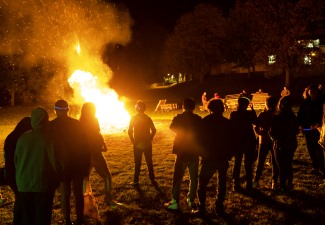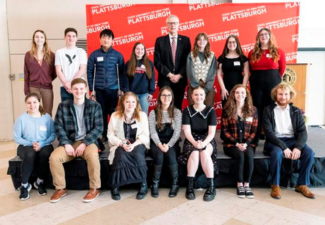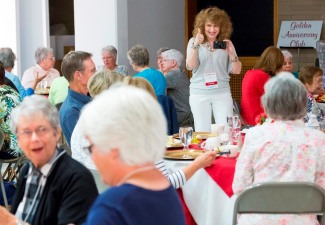SUNY Plattsburgh Anthropology Alumnus Haagen Klaus Rescues History
Haagen Klaus sees dead people. Lots and lots of dead people.
The bioarchaeologist — and assistant professor in both anthropology and biology at Utah Valley University — studies the excavated bodies of ancient Andeans in the Lambayeque Valley, Peru. Through the bones, teeth and other bits of evidence found at the South American site, Klaus has been able to uncover a wide range of data that shows how these people lived and died. Many were killed in ritual sacrifice a thousand years ago.
Seeds Planted Here
Klaus discussed his work — and life since graduating in 2000 — during Homecoming Weekend in October when he returned to campus as a distinguished visiting alumnus. Klaus praised the foundation of his anthropological career, cemented under the tutelage of Drs. Gordon Pollard and Mark Cohen, professors of anthropology.
“Gordon Pollard taught me how to dig using the archaeological method. Mark Cohen taught me paleopathology. But more than the tangible skills, they taught me a love of learning, the joy of sharing what we know, what we consider important,” Klaus said. “The impact of the education I received here wasn’t immediately visible in my life, but as I continued in my training and professional development, I could see the results of the seeds planted here. I can’t tell you how sincerely and profoundly grateful I am to these people and this institution."
Thanking the Genes That Gave Him Eyeglasses
But those seeds were almost sewn elsewhere, and before he thanked the SUNY Plattsburgh anthropology department, Klaus thanked the genes that gave him eyeglasses.
When he was about 10 years old, Klaus and his father were driving in the fields near their home on the east end of Long Island “when all of the sudden, at an altitude of 150 degrees, in front of our car, an F-14 Tomcat flew in front of us. It climbed vertically into the sky, swung around and came around for a landing. I was hooked.
“Many kids have heroes — baseball players, rock stars. Mine were test pilots from the Grumman Corporation,” Klaus said. Seeing the F-14 that day clinched it: he was going to apply to the U.S. Naval Academy and follow in his heroes’ footsteps. “But those were the days when they wouldn’t accept anyone with corrected vision. My dreams were dashed.”
Dr. David Mowry, then-director of the Honors Center, invited him to be in the Honors Program, and Klaus spent his first two years “trying every major under the sun.”
Nothing clicked.
At the end of his sophomore year, he decided he’d quit college and find a job in Vermont with the Air National Guard. “There are plenty of jobs there that would give me daily contact with fast jets.”
But Pollard convinced him to give archeology a try at a dig in Clintonville, just south of Plattsburgh.
“Within the first five minutes being on that site, I felt something I can only describe as profound happiness. I had found ‘it,’” he said. “It combined my love of science, history, and the unknown. All these things just clicked. I knew I would be doing some form of archeological science until the day I die.”
Rescuing History
With that, Klaus said, he began to take every anthropology class he could. An independent study with Cohen, working with the distinguished professor’s extensive collection of ancient Maya bones, further propelled Klaus toward the field.
“I discovered the extraordinary depth of information about human society and behavior that you can glean from people’s bones and teeth,” he said. “If you have the teeth of ancient people, you can reconstruct the civilization of those people. They’re powerful windows into the past.”
As director of Utah Valley University’s Lambayeque Valley Biohistory Project, Klaus works with archeologists and students as they excavate and analyze the ruins and burials of ancient inhabitants, recently discovering the skeletons of dozens of children who had been killed as part of ritual sacrifice.
“Being a field archeologist is tremendously hard work but tremendously important,” Klaus said. “The goal is to understand a little more about history. In a sense, we’re rescuing history because otherwise, it’s gone.”
News
Knelly Named Special Adviser to SUNY for Clinton Transition

Sports Hall of Fame, Unity Day at the Pond Among Homecoming 2023 Highlights
SUNY Plattsburgh Grad Finalist at National Entrepreneurship Competition

North Country Scholarship Program marks 15 years of investing in region’s top students
Alumni Laud Faculty Connections, Experiences for Successful Career Paths
